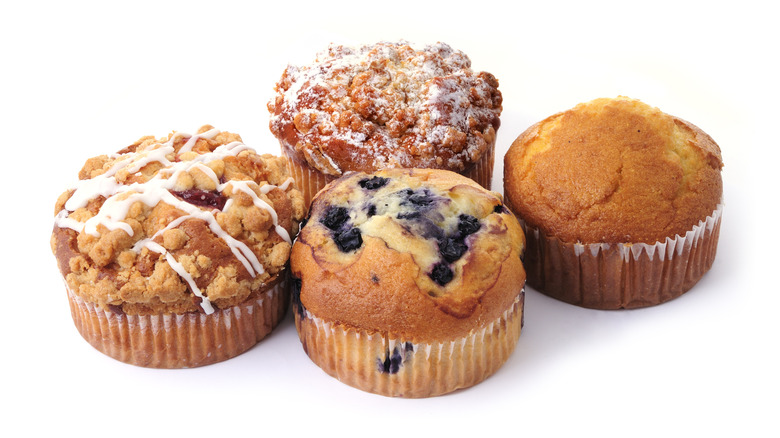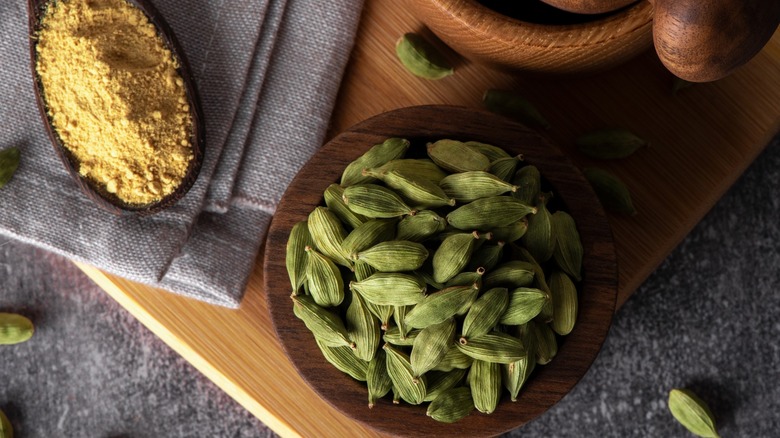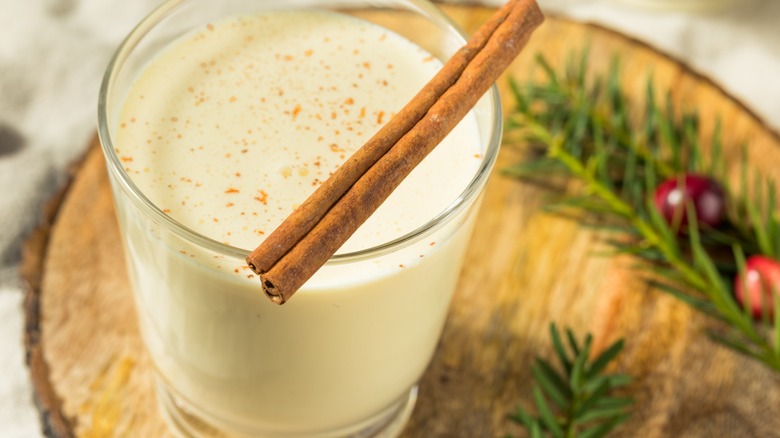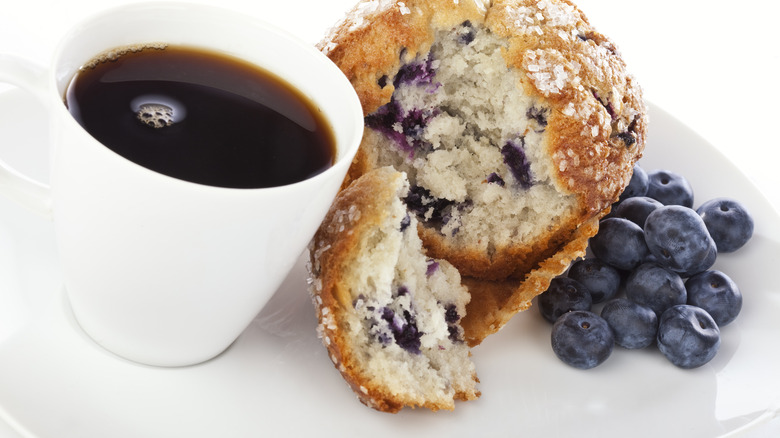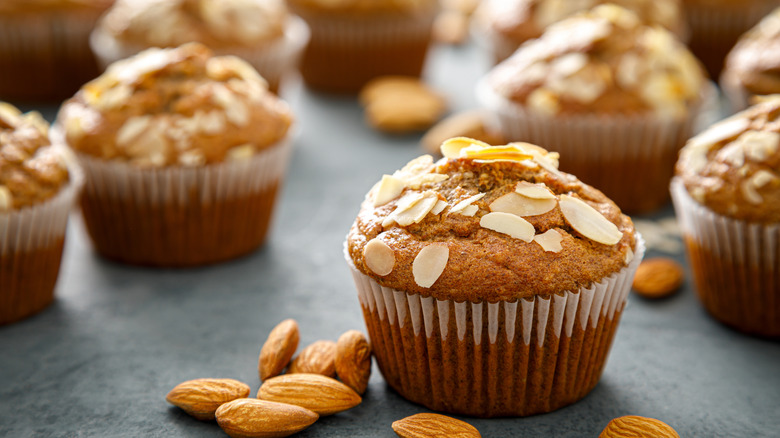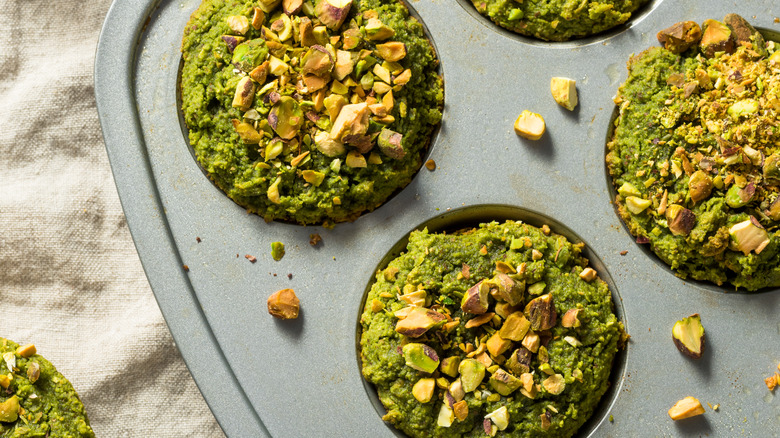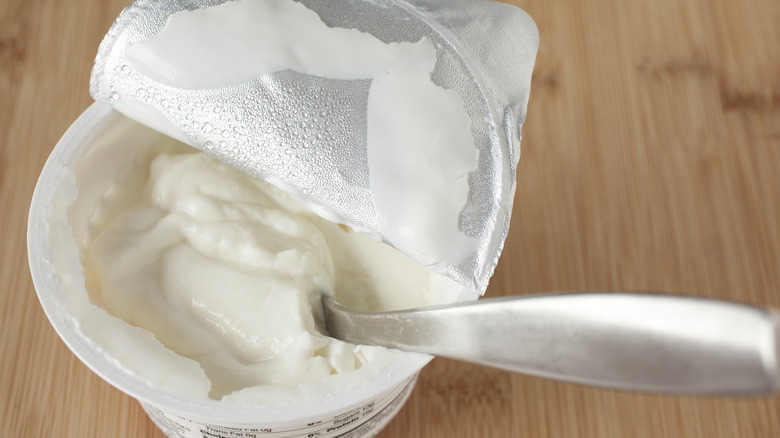17 Ingredient Additions To Take Your Muffins To The Next Level
Muffins are quick and easy to make — they are a type of quick bread, after all — and have the advantage of being a blank canvas for countless variations. The variety of additions is virtually limitless. The ultimate muffin is tender, moist, light, fluffy, and delicious, the result of a balancing act between proper proportions of fat, sugar, and starch.
First, start with a basic muffin recipe to take muffins to the next level. Michael Ruhlman's magic ratios for muffins are two parts flour to two parts liquid and one part fat to one part eggs, according to "Ratio: The Simple Codes Behind the Craft of Everyday Cooking." That means using the same amount of flour or dry ingredients and total liquid (milk, yogurt), and both the fat (oil, butter) and eggs should measure half of the flour.
The key to adding additional ingredients to a basic muffin recipe is to be careful how much extra moisture is added. The more moisture-rich ingredients added, the more dry ingredients required, and the more mixing needed. Over-mixing the batter leads to tough muffins, elongated holes (or tunnels), and misshapen tops. Avoid these common muffin mistakes, however, and your efforts and creativity will be rewarded.
Mangos
Berries, stone fruits, and even tropical fruits can be added to plain muffins. Tropical fruits add a natural sweetness allowing for a reduction of the amount of sugar in the recipe. Additionally, a bit of vanilla combined with the tropical fruits, especially with diced mangoes, enhances their flavor and adds depth and complexity.
Remember, size matters. Be like Goldilocks and ensure the pieces are not too big or too small. To help the fruit be evenly dispersed throughout, place some plain mix on the bottom of the muffin tin, then add the fruit and top with an additional amount of plain mix.
Fresh, in-season mangoes are best, but frozen or dried will also work. Frozen fruit should be completely thawed, rinsed, and drained before adding them to the batter. Wayne Gisslen says in "Professional Baking" that this step prevents colors from bleeding and excess juice from sogging out your batter. Dried fruit should be rehydrated before use. A good method is to soak the fruit in boiling water or sweet wine until soft before draining and adding to the mix.
Almond butter in place of regular butter
Nuts and seeds add protein, good unsaturated fat, and mouthfeel to an otherwise plain muffin. The vegan baking trick of adding nut butter in place of regular butter adds a nutritious twist and flavorful swirl. Almost any nut butter will work, but be aware the taste of nuts might dominate other flavors in the muffin. For those with tree nut allergies, soy nut butter and sunflower seed butter are the best substitutions and will give health and texture benefits without the symptoms.
Almond butter's slightly nutty flavor is perfect for breakfast muffins. The high-protein levels in the almond butter give added structure. That structure is needed, especially if half of the regular wheat flour is substituted with almond flour in the recipe. Look for a great-tasting almond butter that contains only dry-roasted almonds and no added sugar, salt, or oil. Make sure to sprinkle sliced almonds on top before baking to add a bit of texture and mouthfeel.
Basil
Italian basil has an affinity for both sweet and savory foods. Fresh basil compliments savory foods like tomatoes, such as in Caprese salad and summer squash in ratatouille, and works equally as well with lemons and berries. Adding a fresh herb to a sweet quick bread does require a bit of flavor balancing. Herbs add a delicate freshness, fragrant perfume and, if used properly, can enhance rather than dominate the other ingredients.
Strawberries and basil are not a new combination, but it is one that works in a Spring salad, afternoon daiquiri, a morning smoothie ... or a muffin. Strawberry basil muffins combine fresh strawberries, roughly chopped fresh basil, a touch of freshly grated lemon zest, and a hint of ground black pepper. Don't leave out the black pepper. It stimulates the palate and rounds out the sweet berry and savory basil. The lemon zest adds a little tangy tartness and floral fragrance without adding any additional moisture to the recipe.
Broccoli
As with sweet muffins, savory variations are endless. One key to using savory muffin ingredients is to make sure that the flavor profiles play nice. A broccoli, cheddar, corn, and scallion muffin is classic and familiar while being slightly daring at the same time. Fresh or frozen broccoli florets work beautifully, but make sure it is cut into small pieces, cooked, cooled, and dried of excess moisture before adding to the muffin mix. Correctly blanching the broccoli will remove the broccoli's slight bitterness, brighten the color, and result in an appealing texture.
The broccoli will need some companions to promote the muffin beyond the ordinary. Sweet corn kernels balance the cheddar's richness, the broccoli's savory vegetable flavor, and the scallions' light onion spiciness. If that combination is a bit overwhelming, try broccoli, ham, and cheese; broccoli with a touch of red pepper flake; or broccoli with a bit of ground mustard powder for a tongue-tingling sharpness.
Cardamom
Spices can add volume, weight, seasonality, and authenticity to recipes. They bring heat, warmth, balance, and even love to the party. Adding cardamom to a simple blueberry muffin lends a citrusy mint-like flavor, heady pungent fragrance, and pleasant sweet aftertaste to this Indian-inspired breakfast treat. Cardamom also pairs with dark chocolate. The mouth-coating richness and slight bitterness of dark chocolate in a cardamom chocolate muffin balance the spicy complexity of the added cardamom.
Besides flavor, according to Healthline, cardamom has the added benefits of lowering blood pressure, fighting inflammation, and may even heal ulcers and help fight cancer. Look for green cardamom pods or seeds. It is the most common and most aromatic variety. Cardamom is a strong, screaming, zesty spice related to ginger, so be careful not to use too much. For the best results, grind it just prior to adding it to the recipe and add it sparingly.
Eggnog in place of milk or cream
What to do with leftover eggnog during the holidays? Eggnog muffins! Use eggnog to replace the milk or cream in a basic muffin recipe. The eggnog provides a spicy nuttiness and warming sweet creaminess not normally found in a basic muffin.
Eggnog muffins do not need too many additions. Folding in fresh or frozen cranberries or dried craisins will provide a welcoming pleasant tartness. White chocolate chips and shaved white chocolate topping will add a buttery sweetness and a slight floral overtone to the plain eggnog quick bread. Even better, add mashed overripe bananas along with the eggnog and white chocolate for a decadent moist, and tender muffin.
Fresh grated orange zest, vanilla extract, a dash of ground ginger, and a splash of brandy, bourbon, or rum will elevate any of the eggnog combinations to the extraordinary. Don't forget a brown sugar pumpkin pie streusel topping to enrich the festive flavors even more.
Mayonnaise
Mayonnaise is a condiment typically reserved for hamburgers and fancy aiolis, but muffins are the next food that would benefit from a dollop. You should consider using mayo in your next batch of muffins because the ingredient adds a ton of moisture and softness to the crumb structure, producing a muffin resistant to drying.
Albeit unconventional, you will think twice about using this ingredient when you realize it's made of ingredients found in baked goods anyway — like eggs, oil, and vinegar (acid). We recommend swapping out the oil and eggs in the recipe for mayonnaise and following a ratio of three tablespoons of mayo per each egg the recipe requires.
Besides adding mayonnaise to your muffin batter, you should also monitor your methodology to prevent drying them out. This includes cooking your muffins longer than the intended bake time and "cooling" them in the tin after baking, as this causes the sides of the muffins to continue cooking even after the oven has been turned off.
Oil and butter
The fats you choose for your muffin recipe play an important role in the structure and consistency of the final bake. Without any fat, your muffins would come out dry and tasteless. But, with too much fat, you risk over-saturating the other ingredients and making for a greasy breakfast. When choosing your fat for the absolute best muffins, we recommend using a combination of butter and neutral oil, like vegetable or canola oil. This is because the butter will provide the sublime flavor to your muffins, while the oil — because it's made of 100% fat rather than a combination of fat and water — will keep your batter moist and decadent.
You've probably heard of the healthy alternative of swapping out applesauce or mashed banana for the oil. Although this does diminish the calories, the muffin won't be as soft and plush as if you followed the regular recipe.
Raw sugar on top
If you've ever bought muffins from a bakery, you've probably noticed the finishing touch of the crystallized sugar on top. Not only does this element add a distinct shimmer to the baked good, but it also produces a textural contrast when you bite down. In short, our version of the perfect muffin always has a sprinkle of sugar on top.
But this isn't just any granulated sugar. It's likely either turbinado sugar or sanding sugar. Turbinado is a type of raw sugar with a larger grain than granulated sugar. When turbinado sugar is baked on a muffin, it does not seep into the batter but rather forms a crunchy exterior. Sanding sugar is typically between the size of granulated and coarse sugar. It can come in other colors besides clear, which can add a fun pop to your muffin recipe.
Regardless of the type of sugar you use, you should always apply it before baking so that the crystals adhere to the muffin. Add a swipe of butter to the top of each muffin, sprinkle with the sugar, and bake as directed.
Nuts
Nuts are an easy way to make muffins seem deceptively healthy — and to add a surprise element of crunch to the baked good. Some of our favorite nuts to add to muffin recipes include pecans in recipes like our pecan pie muffins, almonds, and walnuts. However, you can also get creative and mix in some pistachios or hazelnuts.
Most recipes use raw nuts, but you can also lightly toast them before adding them to the batter for a more profound flavor. You can toast your nuts in the oven or on the stovetop. If you're going the traditional oven route, spread the nuts out on a baking sheet and bake at 350 degrees Fahrenheit for five to 10 minutes, depending on the type of nut you're working with. Smaller, fattier nuts tend to toast faster, so keep an eye on the oven to avoid burning. If you're going with the stovetop, plan to shake the nuts around a heavy bottom pan for a while — or just go for the hands-off oven approach instead.
Matcha
Matcha is an ingredient that has jumped into the spotlight in recent years. Although green powder is often used for teas and lattes, it also has a respectable place with your baking ingredients. You can make matcha muffins to enjoy with a morning or afternoon cup of tea. This recipe uses ceremonial-grade matcha powder, which is a product intended to be dissolved in liquid and drunk. We also recommend using almond flour for these matcha muffins to add a more complex flavor and complementary texture. Like other recipes, you'll add the matcha to the dry ingredients before adding your wet ingredients.
Matcha muffins are best served with a drizzle of lemon glaze or a sprinkle of powdered sugar. This recipe is pretty hearty, too — meaning that your muffins will last in an air-tight container on the counter for up to five days. But with how delicious they are, we don't think it's possible for them to last that long.
Buttermilk
Never underestimate the power of buttermilk. This tangy, unique dairy ingredient is made from milk that has undergone fermentation, which makes the beverage thicker and more complex in flavor. It can be added to everything from fried chicken to mashed potatoes — and yes, muffins too!
You should consider adding a splash of leftover buttermilk to your muffins. The acidic properties of the ingredient will tenderize the crumb structure and add to the moisture in the batter. Plus, you can always freeze the buttermilk, thaw it, and add it to whatever baked goods you need it for. Alternatively, you can combine one cup of milk (either dairy-free or regular) and a tablespoon of acid (like apple cider vinegar, white vinegar, or lemon juice) to make your own buttermilk substitute in a pinch. Stir the two together and leave it on your countertop for a few minutes to thicken before mixing it in with your wet ingredients.
Greek yogurt
Greek yogurt is another ingredient you likely already have in your pantry that will elevate your muffin's texture. It's the secret to extra moist banana nut muffins; you'll need to directly add the yogurt (in addition to the eggs and oil) to the batter. We always recommend using plain, unsweetened Greek yogurt for the batter. Although it's not as pleasant to eat on its own, it won't make the batter too sweet and throw off the balance of the other ingredients.
Will regular yogurt suffice if you don't have a tub of the Greek variety in your fridge? It's important to note that regular yogurt has a looser consistency than Greek yogurt, so you'll need to use less than the recipe calls for. You can also thicken your regular yogurt by putting it in a fine mesh sieve and allowing it to drain for several hours before adding it to the batter.
Streusel
The only thing better than a coarse sugar topping is a streusel. It's the perfect topping for delicious cinnamon muffins because the topping highlights the sweet, spicy undertones of the recipe and provides a distinct textural element to every bite.
At its core, streusel is just a mix of fat, flour, sugar, and often cinnamon. Crumble the fat (which is most often butter) into the dry ingredients and sprinkle it on top of the muffins before baking. Some recipes will also call for melted butter instead of whole chunks to help the mixture combine better together — but we're fans of the traditional streusel topping. Beyond this base, you can add spices to your streusel topping, like chai spices, warm cloves, and allspice. As for the best base to pair with the streusel, we always recommend fruity muffins, like cranberry, wild berry, or blueberry, but a hearty oatmeal or bran muffin recipe also works well.
Grated zucchini
The summer season is the time of year when you have so many zucchinis in your garden but not enough ways to use them. Grating zucchini into your muffins is an easy way to use up the leftover fruits of your labor and get a healthy dose of vegetables in with your breakfast. After all, it's green, so it must be healthy.
One of our favorite ways to use this summer squash is to combine it with other fruit. Try making a zucchini banana bread muffin recipe for a dose of vitamins A and C. You can shred your zucchini with a box grater or a food processor outfitted with the correct blade. The latter method produces evenly-sized flecks of zucchini (and won't risk rubbing the skin off your hand). You also won't have to worry about draining the extra water out of the zucchini before mixing it in right before you portion your muffins into the tin either.
Oatmeal
December 19 is National Oatmeal Muffin Day — but we think it's worth celebrating these treats every day of the year. Not only are these muffins a blank canvas to pair with other ingredients like chocolate, dried fruit, and bran, but they also give you a healthy boost of fiber that will keep you energized and full for a long time.
The extra step you need for moist oatmeal muffins is to always soak the oats before mixing them into the batter. Oats contain beta-glucan, an indigestible fiber that tends to suck in the moisture from the surrounding batter. This leads to muffins that are dry, crumbly, and unappetizing. Mixing your whole, old-fashioned oats with milk for 20 minutes will help hydrate the grain and prevent the batter from drying as it bakes. You'll be rewarded with creamy, soft muffins that are perfect for serving with other breakfast foods or eating as an afternoon snack.
Chocolate
If you want to know how to make any baked recipe better, we'll tell you the secret: chocolate.
Adding chocolate to muffins can look like a lot of different things. For some recipes, it's mixing in the same semi-sweet chips you'd use for a chocolate chip cookie recipe. You can also play with more complex flavors, such as bittersweet chocolate, to add depth to your recipe but not make it overtly sweet. We recommend the double-chocolate route with cocoa powder and chocolate chips or a triple-chocolate muffin with white, dark, and milk chocolate chips. When this ingredient is involved, there are no limits to the amount of combinations you can make.
Regardless of the type of chocolate you choose to add to your batter, you should always mix it after you've already combined your other ingredients — and avoid the dreaded over-mixing. After your chips or chunks are distributed, put down the spoon. Or else, you'll risk over-developing the gluten and turning the batter stodgy.
